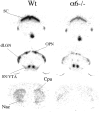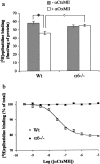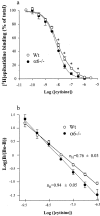Distribution and pharmacology of alpha 6-containing nicotinic acetylcholine receptors analyzed with mutant mice
- PMID: 11850448
- PMCID: PMC6757563
- DOI: 10.1523/JNEUROSCI.22-04-01208.2002
Distribution and pharmacology of alpha 6-containing nicotinic acetylcholine receptors analyzed with mutant mice
Abstract
The alpha6 subunit of the nicotinic acetylcholine receptor (nAChR) is expressed at very high levels in dopaminergic (DA) neurons. However, because of the lack of pharmacological tools selective for alpha6-containing nAChRs, the role of this subunit in the etiology of nicotine addiction remains unknown. To provide new tools to investigate this issue, we generated an alpha6 nAChR knock-out mouse. Homozygous null mutants (alpha6-/-) did not exhibit any gross neurological or behavioral deficits. A careful anatomic and molecular examination of alpha6-/- mouse brains demonstrated the absence of developmental alterations in these animals, especially in the visual and dopaminergic pathways, where the alpha6 subunit is normally expressed at the highest levels. On the other hand, receptor autoradiography revealed a decrease in [3H]nicotine, [3H]epibatidine, and [3H]cytisine high-affinity binding in the terminal fields of retinal ganglion cells of alpha6-/- animals, whereas high-affinity [125I]alpha-conotoxinMII (alphaCtxMII) binding completely disappeared in the brain. Moreover, inhibition of [3H]epibatidine binding on striatal membranes, using unlabeled alphaCtxMII or cytisine, revealed the absence of alphaCtxMII-sensitive and cytisine-resistant [3H]epibatidine binding sites in alpha6-/- mice, although the total amount of binding was unchanged. Because alphaCtxMII, a toxin formerly thought to be specific for alpha3beta2-containing nAChRs, is known to partially inhibit nicotine-induced dopamine release, these results support the conclusion that alpha6 rather than alpha3 is the partner of beta2 in the nicotinic modulation of DA neurons. They further show that alpha6-/- mice might be useful tools to understand the mechanisms of nicotine addiction, although some developmental compensation might occur in these mice.
Figures







References
-
- Bansal A, Singer JH, Hwang BJ, Xu W, Beaudet A, Feller MB. Mice lacking specific nicotinic acetylcholine receptor subunits exhibit dramatically altered spontaneous activity patterns and reveal a limited role for retinal waves in forming ON and OFF circuits in the inner retina. J Neurosci. 2000;20:7672–7681. - PMC - PubMed
-
- Boye SM, Grant RJ, Clarke PB. Disruption of dopaminergic neurotransmission in nucleus accumbens core inhibits the locomotor stimulant effects of nicotine and d-amphetamine in rats. Neuropharmacology. 2001;40:792–805. - PubMed
-
- Cartier GE, Yoshikami D, Gray WR, Luo S, Olivera BM, McIntosh JM. A new alpha-conotoxin which targets alpha3beta2 nicotinic acetylcholine receptors. J Biol Chem. 1996;271:7522–7528. - PubMed
-
- Charpantier E, Barneoud P, Moser P, Besnard F, Sgard F. Nicotinic acetylcholine subunit mRNA expression in dopaminergic neurons of the rat substantia nigra and ventral tegmental area. NeuroReport. 1998;9:3097–3101. - PubMed
-
- Corrigall WA, Coen KM, Adamson KL. Self-administered nicotine activates the mesolimbic dopamine system through the ventral tegmental area. Brain Res. 1994;653:278–284. - PubMed
Publication types
MeSH terms
Substances
Grants and funding
LinkOut - more resources
Full Text Sources
Other Literature Sources
Molecular Biology Databases
